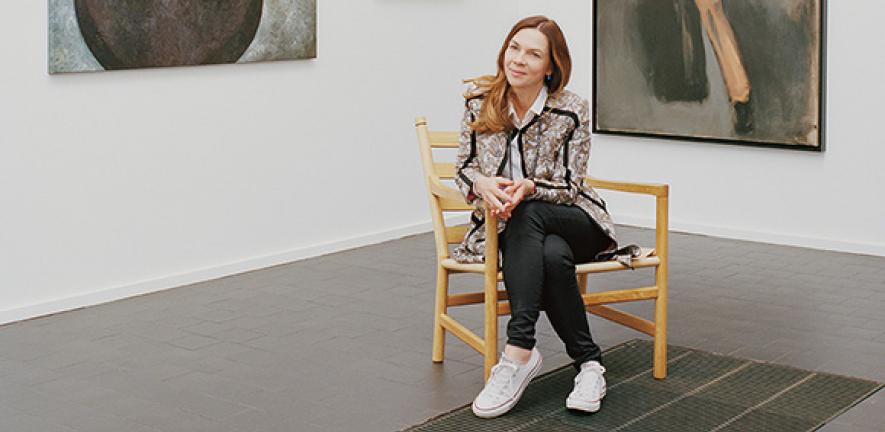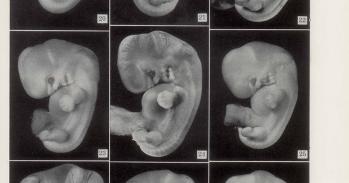
Last year, Magdalena Zernicka-Goetz, Professor of Mammalian Development and Stem Cell Biology, made not one, but two world-changing discoveries.
Last year, Magdalena Zernicka-Goetz, Professor of Mammalian Development and Stem Cell Biology, made not one, but two world-changing discoveries.
Lots of famous scientists had tried it and failed, so they told me I should not be wasting my time. But seven years ago, I decided to return to my dream. And it worked.
Professor Magdalena Zernicka-Goetz
Walk into Professor Magdalena Zernicka-Goetz’s laboratory and it is her sofa that catches your eye. A gaudy pink-purple, it is easily visible through the glass that separates the benches, fridges and microscopes from the office where she draws the threads of her thinking together. It converts into a bed – handy for all-night experiments. And it’s where her team sat, last year, when, during a regular update meeting, they realised that they’d made a world-changing discovery. They had created a structure resembling a mouse embryo, entirely in the laboratory, using stem cells: a world first.
“I still remember that moment,” says Zernicka-Goetz, Professor of Mammalian Development and Stem Cell Biology and group head of the Zernicka-Goetz Laboratory. “It is one of the most happy moments in your life, when your dreams come true. You work on something, very intensively. You often have to inspire and motivate people in the lab to work on it. These are super-intelligent people. They do it because they see a value in it, not because you are telling them to. And the result is very much a team success.”
Until she was four, Zernicka-Goetz lived in her father’s scientific laboratories. Her family had lost everything during the war, including their home. Now, growing up in Warsaw, behind the Iron Curtain, the laboratory was home: a lab converted into the family’s apartment, with the kitchen installed in a corridor. Zernicka-Goetz would walk to her pre-school, hand in hand with her father, Professor Boguslaw Zernicki and together they would discuss his passion: the brain. How do we think? Why do we think? Where do our dreams come from? The young Zernicka-Goetz was encouraged to dig deep, to probe cause and effect.
“At the time, I didn’t realise it was inspirational,” she says. “Now, tracing my steps back, I can see the connection. At school, my biology teacher wasn’t so great. I wouldn’t have been so fascinated by science if I hadn’t had this charismatic father, motivated not by career progression, but by pure science.”
She came to Cambridge in 1995 as an EMBO Fellow, supervised by Professor Sir Martin Evans (who discovered embryonic stem cells). Her fascination, nurtured during her PhD at the University of Warsaw under the supervision of Professor Andrzej Tarkowski, was around the plasticity of embryos. They are gloriously flexible, she says: remove one cell from an embryo and the rest will develop normally. “We know that they can recover from their different perturbations in early life, but how does that work? How do they recover? Embryos of many other animals can’t do this, but mammalian embryos can. Why? The process fascinated me.”
She deliberately chose a different specialisation to her father’s, not wanting to be directly compared to him. But when it comes down to it, she says, both areas are all about cells. “I was fascinated by our thoughts and where they come from, and how it can all be narrowed down to the function of individual cells within the brain,” she says. “I like painting and sculpture, which somehow translates into playing with embryos and stem cells. Making shapes with them – that’s what helps me to think and sometimes inspires me.”
Zernicka-Goetz’s playful and imaginative attitude to the astonishingly complex structure that is the mammalian embryo has given rise to some extraordinary work. In 2016, Nature and Nature Cell Biology published her papers outlining a new technique for allowing human embryos to develop in the lab for up to 13 days. Previously, embryos could survive in vitro for only seven days (the point at which an embryo would normally implant into the womb).
The new technique is vital for studying early pregnancy loss. Under UK law, researchers are permitted to study human embryos in the lab for up to 14 days, but as no method existed for keeping them alive after seven days there was no way to study the changes which might be taking place. Then came Zernicka-Goetz’s technique, which involves creating a system in the lab which allows embryo cells to organise themselves to form a basis for future development, just as they do in the womb.
Zernicka-Goetz had wanted to develop just such a system from her very early days as a scientist. “I very much wanted to grow these embryos beyond the so-called ‘blastocyst’ stage – the fourth day of their life in the culture dish. This is when the transformation of an embryo’s architecture happens. Nature looks very different before the embryo is implanted, and afterwards.” Her supervisors discouraged her. Far too difficult, they said. “Lots of famous scientists had tried it and failed, so they told me I should not be wasting my time. But seven years ago, I decided to return to my dream. And it worked.” That work resonated around the world, winning the People’s Choice award for Science magazine’s ‘Breakthrough of the Year 2016’.
Then, this spring, came her work on growing mouse embryo-like structures. Zernicka-Goetz was on her way to Paris to make a speech when she heard of the paper’s publication (authors are not told in advance when their papers will be published in scientific journals). Interest was phenomenal – the world’s media descended on her. “It was a very important speech, which I was honoured to have been asked to give, and I didn’t want to cancel,” she remembers. “So I spent the whole journey on the Eurostar on the phone to journalists. It was actually more stressful than happy as I wanted to be part of it, but had to delegate it to people in the lab, and to everybody who I knew I could rely on reporting the story accurately and say: please go to the TV studio and speak about it, because I can’t do it! I have to give this speech!”
How did her team achieve this landmark when all other efforts failed? Like many discoveries, it came about through a new way of thinking about the problem, says Zernicka-Goetz. The key to her success lay in the use of two different kinds of stem cells. “The first type of cell, pluripotent embryonic stem cells, make the mouse baby. The second type, multipotent trophoblast stem cells, make the placenta,” she explains. “We allowed these two types of stem cells to interact with each other by providing an extra-cellular matrix to help them communicate – a kind of 3D scaffold. We hoped that they would self-organise to create an embryonic structure – and they did.”
It is important to understand that this is not ‘creating life’. Her team will not be attempting to ‘grow’ baby mice in the lab. Rather, Zernicka-Goetz says, this work is providing a system to enable scientists to better understand development. Using actual mouse embryos in research is not ideal: they are complex structures which aren’t easy to grow at the life stage that is of interest to Zernicka-Goetz’s team. Mimicking the developmental processes taking place in these embryos using stem cells is far more convenient. “And this is of enormous importance,” she says. “This is the stage where many human pregnancies fail. Human and mouse development at this time have a lot of common elements. So using this system, we will be able to identify the role of specific genes and processes, and the communication between different kinds of cells in order to build the organism.”
Two world-changing discoveries in a year is an astonishing record, but Zernicka-Goetz says she doesn’t necessarily feel proud. “Often, in life, things are mixed,” she says. “You have to deal with happy moments and difficult moments. The difficulty for me is still mastering my balance between my life as a scientist and teacher and mother and friend and wife. During the normal day, I often run to keep up with it all – all those different lives. So when the unusual happens, it is overwhelming and you feel not proud but rewarded. Rewarded for all this effort, and training, and forgetting about your own feelings and life for what you are trying to achieve.”
It’s hard for her to predict the future, she says. Her lab is currently working on 17 different projects. Her ideas develop as they go along, she says, but behind them, always, lurk the biggest of big questions: where does life come from? How does it start? And why do we still know so little about it? “I often wake up with ideas,” she says. “Perhaps I see something during the day, or I think of something in conversation, or when I am discussing something with my kids. Sometimes I go for a run and I think about how we might solve a specific problem. But the important question for me is to find a way to address those big questions. We know there are many things we don’t know, so how do we find out about them?”
Article by Lucy Jolin. This article first appeared in CAM - the Cambridge Alumni Magazine, issue 81.




